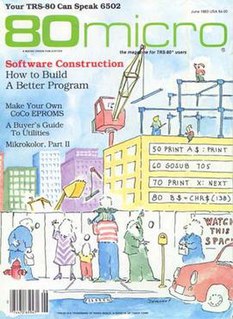This page is based on this
Wikipedia article Text is available under the
CC BY-SA 4.0 license; additional terms may apply.
Images, videos and audio are available under their respective licenses.

Tandy Corporation was an American family-owned leather goods company based in Fort Worth, Texas, United States. Tandy Leather was founded in 1919 as a leather supply store and acquired a number of craft retail companies, including RadioShack in 1963. In 2000, the Tandy Corporation name was dropped and the entity became the RadioShack Corporation.
Microsoft BASIC is the foundation product of the Microsoft company. It first appeared in 1975 as Altair BASIC, which was the first BASIC by Microsoft and the first high level programming language available for the Altair 8800 microcomputer.

The Sharp PC-1500 was a pocket computer produced by Sharp during 1981-1985. A rebadged version was also sold as the TRS-80 Pocket Computer PC-2.

The Sharp PC-1211 is a pocket computer marketing by Sharp Corporation in the 1980s. The computer was powered by two 4-bit CPUs laid out in power-saving CMOS circuitry. One acted as the main CPU, the other dealt with the input/output and display interface. Users could write computer programs in BASIC.

A Tandy Pocket Computer or TRS-80 Pocket Computer is one of a line of 1980s small pocket computers—calculator-sized programmable computing devices—sold by Tandy Corporation under the "Tandy" or "Radio Shack TRS-80" brands.

The TRS-80 Model 100 is a portable computer introduced in 1983. It is one of the first notebook-style computers, featuring a keyboard and liquid crystal display, in a battery-powered package roughly the size and shape of a notepad or large book.

Video Genie was a series of computers produced by Hong Kong-based manufacturer EACA during the early 1980s. They were compatible with the Tandy TRS-80 Model I computers and could be considered a clone, although there were hardware and software differences.

Scripsit is a word processing application written for the Radio Shack TRS-80 line of computers. Versions were available for most if not all computers sold under the TRS-80 name, including the Color Computer and several pocket computer designs, as well as the Tandy version of the Xenix operating system. Some of these versions are tape-based and have no ability to read or write to disk.

80 Micro was a computer magazine, published between 1980 and 1988, that featured program listings, products and reviews for the TRS-80.

Following the introduction of the IBM Personal Computer, or IBM PC, many other personal computer architectures became extinct within just a few years.

Home computers were a class of microcomputers that entered the market in 1977, that started with what Byte Magazine called the "trinity of 1977", and which became common during the 1980s. They were marketed to consumers as affordable and accessible computers that, for the first time, were intended for the use of a single nontechnical user. These computers were a distinct market segment that typically cost much less than business, scientific or engineering-oriented computers of the time such as the IBM PC, and were generally less powerful in terms of memory and expandability. However, a home computer often had better graphics and sound than contemporary business computers. Their most common uses were playing video games, but they were also regularly used for word processing, doing homework, and programming.
Extended Color Basic is an update to the Color BASIC interpreter for the Radio Shack/Tandy TRS-80 Color Computer series and is the default Basic interpreter, for the Color Computer 2. The Color Computer Basic implementations are somewhat different for the versions of Basic which come with the other family of TRS-80 machines, namely Basic Levels I, II, and III. Assemblers and Pascal and C compilers are available for the different machines in the series. Modified subsets of Color Basic may be found on many of the Radio Shack PC series of pocket computers of the era.
Disk Extended Color Basic is an update to the Color BASIC interpreter for the Radio Shack/Tandy TRS-80 Color Computer series and is the default Basic interpreter, and therefore the de facto operating system, for the Color Computer 3. The Color Computer Basic implementations are somewhat different for the versions of Basic which come with the other family of TRS-80 machines, namely Basic Levels I, II, and III. Assemblers and Pascal and C compilers are available for the different machines in the series. Modified subsets of Color Basic may be found on many of the Radio Shack PC series of pocket computers of the era.













